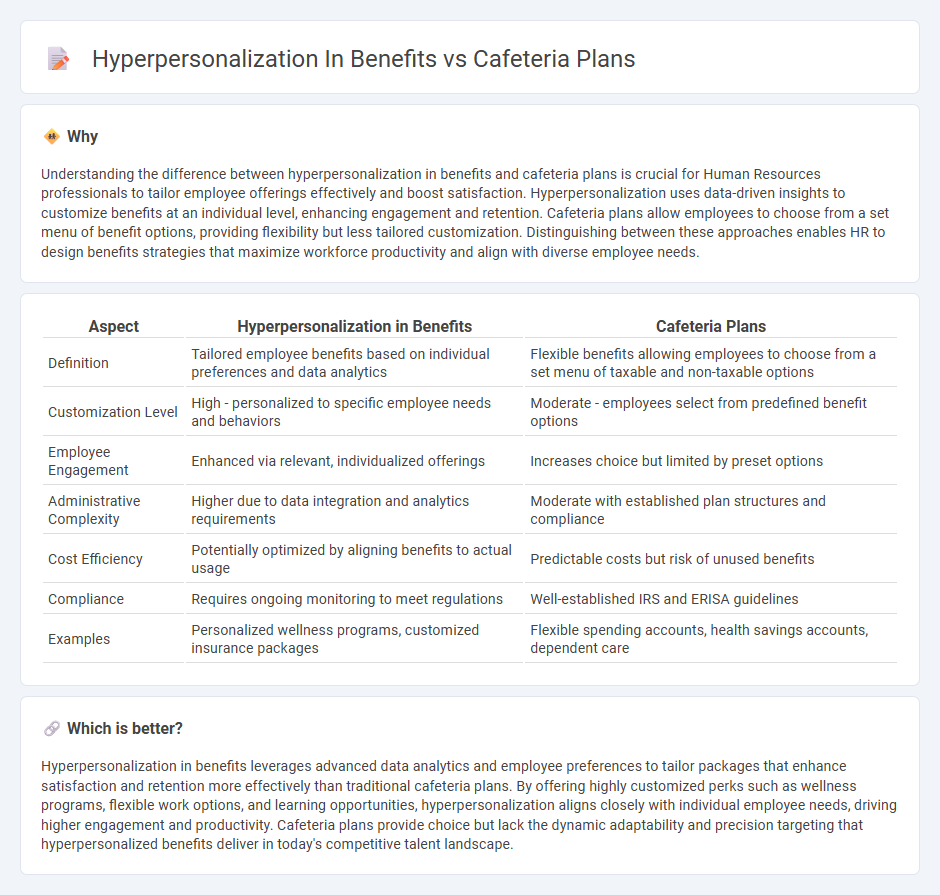
Hyperpersonalization in employee benefits leverages advanced data analytics and AI to customize offerings based on individual preferences, behaviors, and life stages, resulting in higher engagement and satisfaction. Unlike traditional cafeteria plans, which offer a fixed menu of benefits options for employees to select from, hyperpersonalized benefits dynamically adapt to meet evolving needs and circumstances. Discover how integrating hyperpersonalization can transform your benefits strategy and maximize workforce well-being.
Why it is important
Understanding the difference between hyperpersonalization in benefits and cafeteria plans is crucial for Human Resources professionals to tailor employee offerings effectively and boost satisfaction. Hyperpersonalization uses data-driven insights to customize benefits at an individual level, enhancing engagement and retention. Cafeteria plans allow employees to choose from a set menu of benefit options, providing flexibility but less tailored customization. Distinguishing between these approaches enables HR to design benefits strategies that maximize workforce productivity and align with diverse employee needs.
Comparison Table
| Aspect | Hyperpersonalization in Benefits | Cafeteria Plans |
|---|---|---|
| Definition | Tailored employee benefits based on individual preferences and data analytics | Flexible benefits allowing employees to choose from a set menu of taxable and non-taxable options |
| Customization Level | High - personalized to specific employee needs and behaviors | Moderate - employees select from predefined benefit options |
| Employee Engagement | Enhanced via relevant, individualized offerings | Increases choice but limited by preset options |
| Administrative Complexity | Higher due to data integration and analytics requirements | Moderate with established plan structures and compliance |
| Cost Efficiency | Potentially optimized by aligning benefits to actual usage | Predictable costs but risk of unused benefits |
| Compliance | Requires ongoing monitoring to meet regulations | Well-established IRS and ERISA guidelines |
| Examples | Personalized wellness programs, customized insurance packages | Flexible spending accounts, health savings accounts, dependent care |
Which is better?
Hyperpersonalization in benefits leverages advanced data analytics and employee preferences to tailor packages that enhance satisfaction and retention more effectively than traditional cafeteria plans. By offering highly customized perks such as wellness programs, flexible work options, and learning opportunities, hyperpersonalization aligns closely with individual employee needs, driving higher engagement and productivity. Cafeteria plans provide choice but lack the dynamic adaptability and precision targeting that hyperpersonalized benefits deliver in today's competitive talent landscape.
Connection
Hyperpersonalization in benefits and cafeteria plans enhances employee satisfaction by tailoring options to individual preferences, health needs, and lifestyle choices. Leveraging data analytics and AI, organizations create adaptive benefits packages that dynamically adjust to evolving employee circumstances. This strategic alignment drives higher engagement, retention, and overall workforce well-being in human resources management.
Key Terms
Flexible Benefits
Flexible benefits enable employees to customize their compensation packages through cafeteria plans, offering choices such as health insurance, retirement options, and wellness programs tailored to individual needs. Hyperpersonalization, leveraging data analytics and AI, advances flexible benefits by delivering highly targeted options that improve employee satisfaction and engagement. Explore how integrating cafeteria plans with hyperpersonalized benefits can redefine workforce satisfaction and retention strategies.
Employee Choice
Cafeteria plans offer employees a selection of pre-tax benefit options, allowing tailored choices that fit individual needs and financial situations. Hyperpersonalization in benefits goes beyond traditional selections by using data analytics and AI to customize offerings uniquely aligned with each employee's lifestyle, preferences, and career stage. Explore how integrating hyperpersonalized strategies with cafeteria plans can elevate employee choice and satisfaction in your workforce.
Personalized Offerings
Cafeteria plans allow employees to select from a variety of pre-set benefits, offering flexibility but limited customization to individual preferences. Hyperpersonalization in benefits uses data-driven insights to tailor offerings uniquely to each employee's lifestyle and needs, enhancing engagement and satisfaction. Discover how embracing hyperpersonalization can revolutionize your benefits strategy with truly personalized offerings.
Source and External Links
Section 125 Cafeteria Plan: What It Is & How It Works - ADP - A Section 125 cafeteria plan allows employees to pay for certain benefits, like health insurance and flexible spending accounts, with pretax dollars, reducing taxable income and offering potential tax savings.
What is a Cafeteria Plan? | HR & Payroll Glossary - Paylocity - Cafeteria plans are employer-sponsored benefit arrangements that let employees choose between taxable and non-taxable benefits, such as medical, dental, and vision insurance, while complying with IRS Section 125 rules.
Cafeteria Plans Flexible Spending Accounts (FSAs) - Ohio Auditor - Common cafeteria plan options include premium-only plans (POP), health flexible spending accounts (FSA), limited-purpose FSAs, and dependent care assistance plans, all funded by pre-tax payroll deductions and subject to specific IRS regulations.
 dowidth.com
dowidth.com